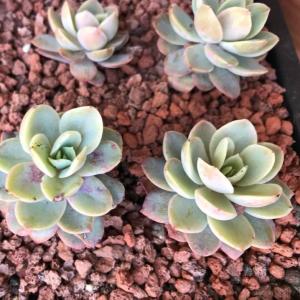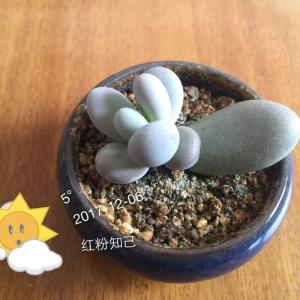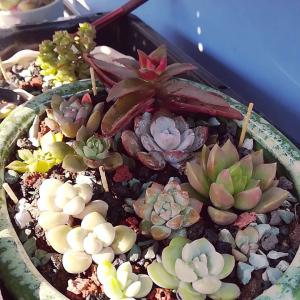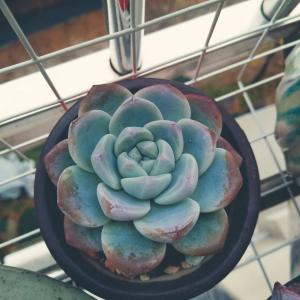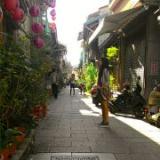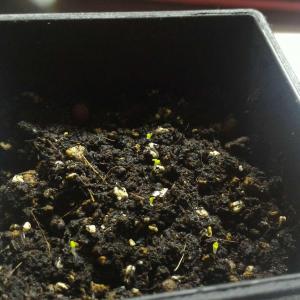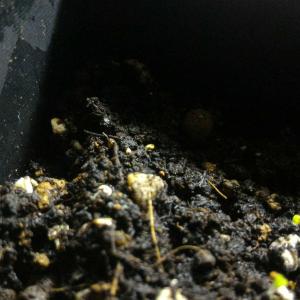文章
Miss Chen
2017年12月13日

Description: This perennial wildflower is 8-20" tall, erect, and unbranched. The central stem is light green to brown, terete, and canescent to short-pubescent. Pairs of opposite leaves occur at intervals along the central stem. The leaf blades are 2-3" long and ¾–1½" across; they are lanceolate, ovate, or oval in shape and their margins are smooth. The upper surfaces of the blades are green and hairless, while their lower surfaces are pale green and canescent to short-pubescent. On each blade, the lateral veins extend outward from the central vein toward the outer margins. The petioles are about ¼" in length. The central stem terminates in a a dome-shaped umbel of flowers about 1½–2" across; there are usually 1-3 additional umbels of flowers that develop from the axils of the upper leaves. Each umbel has 8-24 flowers that are more or less white. Individual flowers are about ¼" across, consisting of a short reproductive column in the center, 5 surrounding hoods with inwardly curving horns, and 5 drooping corolla lobes. The hoods are white or cream-colored, while the corolla lobes are white, greenish white, or pale purplish white. The slender pedicels of the flowers are about ¾–1" long and short-pubescent.
Flowering Plant
The blooming period occurs from late spring to mid-summer and lasts about 3 weeks. Fertilized flowers are replaced by spindle-shaped seedpods (follicles) about 2-3" long that have smooth and canescent outer surfaces. These seedpods are held erect. At maturity, each seedpod splits open along one side, releasing seeds with tufts of light brown hair. The seeds are distributed by the wind. The root system is rhizomatous.
Cultivation: The preference is full or partial sun, dry conditions, and sandy soil; other kinds of soil are tolerated, if water drainage is good. This small milkweed could be cultivated in rock gardens.
Range & Habitat: The native Oval-Leaved Milkweed is rare in Illinois and state-listed as endangered; it is found in only a few northeastern counties. This milkweed is more typical of prairies in the northern plains; Illinois lies at the southeastern limit of its range. Habitats include hill prairies and dry sand prairies, typical savannas and sandy savannas, and openings in upland oak woodlands. Occasional wildfires are probably beneficial as this reduces the encroachment of woody vegetation. Oval-Leaved Milkweed is found in high quality natural areas.
Faunal Associations: The nectar of the flowers attracts many kinds of insects, including long-tongued bees, wasps, ants, butterflies and skippers, and probably some moths. Ants are nectar robbers, but they may provide the flowering plant with some protection from aphids and other small insects. Little information about floral-faunal relationships is available for this milkweed specifically, but in general milkweed species (Asclepias spp.) attract a distinctive group of insects that feed on the leaves and other parts of these plants. These insect feeders include the weevil Rhyssomatus lineaticollis, Lygaeus kalmii (Small Milkweed Bug), Oncopeltus fasciatus (Large Milkweed Bug), Tetraopes basalis (Milkweed Longhorn), Tetraopes femoratus (Large Red Milkweed Beetle), Tetraopes tetrophthalmus (Red Milkweed Beetle), Aphis nerii (Introduced Milkweed Aphid), the aphids Myzocallis asclepiadis and Myzocallis punctatus, the moths Cycnia inopinatus (Unexpected Cycnia) and Cycnia tenera (Delicate Cycnia), and the butterfly Danaus plexippus (Monarch). Because the foliage is toxic and bitter as a result of its milky latex, mammalian herbivores usually avoid milkweeds. Sometimes, the Eastern Goldfinch uses the tufted hairs of the seeds in the construction of its nests.
Photographic Location: A nature preserve in Cook County, Illinois. The photograph of the flowering plant was taken by Lisa Culp (Copyright © 2009).
Comments: This little-known milkweed has reasonably attractive flowers and foliage. It is one of several milkweeds (Asclepias spp.) in Illinois with flowers that are more or less white. To identify Oval-Leaved Milkweed correctly, the following two characteristics should be considered: 1) its stems and leaf undersides are canescent or short-pubescent, rather than hairless or long-haired, and 2) its larger leaves are usually ovate to oval, rather than linear or lanceolate. For example, the white-flowered Asclepias lanuginosa (Woolly Milkweed) has more slender leaves and its stems are covered with spreading hairs. This latter milkweed produces only a single terminal umbel of flowers per plant, while Oval-Leaved Milkweed often produces 1-3 axillary umbels of flowers. Other common names of Asclepias ovalifolia are Dwarf Milkweed and Oval Milkweed.
Flowering Plant
The blooming period occurs from late spring to mid-summer and lasts about 3 weeks. Fertilized flowers are replaced by spindle-shaped seedpods (follicles) about 2-3" long that have smooth and canescent outer surfaces. These seedpods are held erect. At maturity, each seedpod splits open along one side, releasing seeds with tufts of light brown hair. The seeds are distributed by the wind. The root system is rhizomatous.
Cultivation: The preference is full or partial sun, dry conditions, and sandy soil; other kinds of soil are tolerated, if water drainage is good. This small milkweed could be cultivated in rock gardens.
Range & Habitat: The native Oval-Leaved Milkweed is rare in Illinois and state-listed as endangered; it is found in only a few northeastern counties. This milkweed is more typical of prairies in the northern plains; Illinois lies at the southeastern limit of its range. Habitats include hill prairies and dry sand prairies, typical savannas and sandy savannas, and openings in upland oak woodlands. Occasional wildfires are probably beneficial as this reduces the encroachment of woody vegetation. Oval-Leaved Milkweed is found in high quality natural areas.
Faunal Associations: The nectar of the flowers attracts many kinds of insects, including long-tongued bees, wasps, ants, butterflies and skippers, and probably some moths. Ants are nectar robbers, but they may provide the flowering plant with some protection from aphids and other small insects. Little information about floral-faunal relationships is available for this milkweed specifically, but in general milkweed species (Asclepias spp.) attract a distinctive group of insects that feed on the leaves and other parts of these plants. These insect feeders include the weevil Rhyssomatus lineaticollis, Lygaeus kalmii (Small Milkweed Bug), Oncopeltus fasciatus (Large Milkweed Bug), Tetraopes basalis (Milkweed Longhorn), Tetraopes femoratus (Large Red Milkweed Beetle), Tetraopes tetrophthalmus (Red Milkweed Beetle), Aphis nerii (Introduced Milkweed Aphid), the aphids Myzocallis asclepiadis and Myzocallis punctatus, the moths Cycnia inopinatus (Unexpected Cycnia) and Cycnia tenera (Delicate Cycnia), and the butterfly Danaus plexippus (Monarch). Because the foliage is toxic and bitter as a result of its milky latex, mammalian herbivores usually avoid milkweeds. Sometimes, the Eastern Goldfinch uses the tufted hairs of the seeds in the construction of its nests.
Photographic Location: A nature preserve in Cook County, Illinois. The photograph of the flowering plant was taken by Lisa Culp (Copyright © 2009).
Comments: This little-known milkweed has reasonably attractive flowers and foliage. It is one of several milkweeds (Asclepias spp.) in Illinois with flowers that are more or less white. To identify Oval-Leaved Milkweed correctly, the following two characteristics should be considered: 1) its stems and leaf undersides are canescent or short-pubescent, rather than hairless or long-haired, and 2) its larger leaves are usually ovate to oval, rather than linear or lanceolate. For example, the white-flowered Asclepias lanuginosa (Woolly Milkweed) has more slender leaves and its stems are covered with spreading hairs. This latter milkweed produces only a single terminal umbel of flowers per plant, while Oval-Leaved Milkweed often produces 1-3 axillary umbels of flowers. Other common names of Asclepias ovalifolia are Dwarf Milkweed and Oval Milkweed.
0
0
文章
Miss Chen
2017年12月13日

Description: This perennial plant becomes about 2-3' tall when it is mature, branching occasionally in the upper half. The stems are covered in a dense mat of short white hairs. The alternate leaves are up to 3½" long and 1" across. They are usually oblanceolate, narrowly ovate, or linear. The lower leaves may have a few lobes or coarse teeth towards their tips, while the upper leaves have smooth margins. Like the stems, the leaves have a dense mat of short white hairs, especially on the lower surface. This variety of White Sage has dense white hairs on the upper surface of the leaves as well, except for the oldest leaves toward the bottom of the plant. The leaves are sessile against the stem, or have short petioles. Some of the upper stems terminate in elongated spikes or narrow racemes of compound flowers. Each flowerhead is only 1/8" (3 mm.) across, and contains numerous whitish green disk florets that are inconspicuous. The blooming period is late summer to early fall, and lasts about 2-3 weeks. There is no floral scent, although the foliage of this plant is quite aromatic. Pollination is by wind, rather than insects. The tiny seeds are without tufts of hair, but are small enough to be distributed by the wind. The root system is rhizomatous, and can form a dense mat of roots near the surface of the ground. As a result, this plant has a strong tendency to form clonal colonies that exclude other plants.

Cultivation: The preference is full sun and dry conditions. Poor soil containing hardpan clay, rocky material, or sand is actually preferred as a medium for growth, as this reduces competition from other plants. The foliage is very attractive and doesn't have significant problems with disease. This plant can spread aggressively in some situations.
Range & Habitat: White Sage is occasional in northern and western Illinois, but rare or absent in other parts of the state (see Distribution Map). Some authorities think this plant is native to Illinois (e.g., Britton & Brown), while others believe it is adventive from the west (e.g., Mohlenbrock). It is usually found along railroads and roadsides, and sometimes in dry upland areas of prairies. Cultivated forms of this plant can be found in flower gardens because of the attractive foliage. If this plant is native, Illinois would be at the eastern boundary of its distribution.
Faunal Associations: The flowers don't attract insects because they are wind-pollinated. White Sage has the potential to cause allergies in humans because of this pollen, but this species isn't very common within the state. Several grasshopper species feed on the foliage of White Sage (see Grasshopper Table), including an uncommon oligolectic grasshopper, Hypochlora alba (Cudweed Grasshopper), which often feeds hides in the foliage during the day. Other insect feeders include Ophraella artemisiae (Leaf Beetle sp.), Macrosiphoniella ludovicianae (Aphid sp.), and the larvae of Phaneta argenticostana (Tortricid Moth sp.); the moth larvae feed on the seedheads. Mammalian herbivores don't consume this plant because the aromatic foliage has a bitter taste. The seeds are too small to be of much interest to birds.
Photographic Location: The photographs were taken at Meadowbrook Park in Urbana, Illinois, where a small colony of plants was located in a restored prairie. The plants were not in bloom.
Comments: This variety of White Sage has striking foliage. The typical variety, Artemisia ludoviciana ludoviciana, has greener foliage with fewer white hairs. The leaves of this latter variety are supposed to be broader and more likely to have lobes or serrated margins toward the leaf tips. However, the hairiness and shape of the leaves can be rather variable for this species, regardless of the variety. Other Artemisia spp. have foliage that is more green and pinnately lobed. A few species, such as the introduced Artemisia vulgaris (Mugwort), have silvery hairs on the lower surface of the leaves, but their upper surface is predominantly green.

Cultivation: The preference is full sun and dry conditions. Poor soil containing hardpan clay, rocky material, or sand is actually preferred as a medium for growth, as this reduces competition from other plants. The foliage is very attractive and doesn't have significant problems with disease. This plant can spread aggressively in some situations.
Range & Habitat: White Sage is occasional in northern and western Illinois, but rare or absent in other parts of the state (see Distribution Map). Some authorities think this plant is native to Illinois (e.g., Britton & Brown), while others believe it is adventive from the west (e.g., Mohlenbrock). It is usually found along railroads and roadsides, and sometimes in dry upland areas of prairies. Cultivated forms of this plant can be found in flower gardens because of the attractive foliage. If this plant is native, Illinois would be at the eastern boundary of its distribution.
Faunal Associations: The flowers don't attract insects because they are wind-pollinated. White Sage has the potential to cause allergies in humans because of this pollen, but this species isn't very common within the state. Several grasshopper species feed on the foliage of White Sage (see Grasshopper Table), including an uncommon oligolectic grasshopper, Hypochlora alba (Cudweed Grasshopper), which often feeds hides in the foliage during the day. Other insect feeders include Ophraella artemisiae (Leaf Beetle sp.), Macrosiphoniella ludovicianae (Aphid sp.), and the larvae of Phaneta argenticostana (Tortricid Moth sp.); the moth larvae feed on the seedheads. Mammalian herbivores don't consume this plant because the aromatic foliage has a bitter taste. The seeds are too small to be of much interest to birds.
Photographic Location: The photographs were taken at Meadowbrook Park in Urbana, Illinois, where a small colony of plants was located in a restored prairie. The plants were not in bloom.
Comments: This variety of White Sage has striking foliage. The typical variety, Artemisia ludoviciana ludoviciana, has greener foliage with fewer white hairs. The leaves of this latter variety are supposed to be broader and more likely to have lobes or serrated margins toward the leaf tips. However, the hairiness and shape of the leaves can be rather variable for this species, regardless of the variety. Other Artemisia spp. have foliage that is more green and pinnately lobed. A few species, such as the introduced Artemisia vulgaris (Mugwort), have silvery hairs on the lower surface of the leaves, but their upper surface is predominantly green.
0
0
文章
Miss Chen
2017年12月13日

Description: This plant is a biennial or short-lived perennial. During the 1st year, a rosette of basal leaves is produced. The basal leaves are up to 4" long and 3" across; they are deeply pinnatifid or bipinnatifid with narrow linear lobes (up to 2" long and less than 3 mm. across). The upper surface of basal leaves is grayish blue and canescent; the petioles of these leaves are variable in length. During the 2nd and later years (if any), this plant bolts to become 1½-3½' tall, while the rosette of basal leaves withers away. The central stem and ascending lateral stems are light green to dark red and terete. Usually the young tips of stems are tomentose (with short white cobwebby pubescence), otherwise they are mostly glabrous. The cauline leaves alternate along these stems; they are more common along the lower half of the central stem and lower lateral stems. The lower cauline leaves resemble the basal leaves, except they are more green. Middle cauline leaves are smaller in size and less divided into linear lobes, while the upper cauline leaves are short (less than 1" long) and linear in shape. The upper surface of these leaves is green to whitish green, flat, and tomentose, becoming more glabrous with age. The lower surface of these leaf leaves is green, rounded (convex), and glabrous. The foliage is not strongly aromatic.
The central stem (and upper lateral stems, if any) terminates in a panicle of flowerheads that is about 4-18" long and about one-half as much across. Leafy linear bracts occur along the rachis (central stalk) and lateral branches of this panicle. The rachis and lateral branches are light green to dark red and glabrous to canescent. The rachis of the panicle is more or less erect, while its primary lateral branches are ascending. Individual flowerheads are whitish green or yellowish green and 2-4 mm. long and similarly across. Each flowerhead has 8-30 inner disk florets that are perfect and 5-20 outer disk florets that are pistillate. Each inner floret consists of a narrow tubular corolla with 5 teeth along its upper rim, some fertile stamens, and an abortive ovary that is sterile. Each outer floret consists of a narrow tubular corolla with 2-3 teeth along its upper rim and a fertile ovary with a divided style. The base of each flowerhead is surrounded by appressed overlapping bracts (phyllaries); individual bracts are lanceolate to ovate, mostly green, and up to 2 mm. long. At maturity, the flowerheads droop from short pedicels. The blooming period occurs from mid-summer to early autumn, lasting about 2-3 weeks. The florets are cross-pollinated primarily by the wind. Afterwards, the outer florets of the flowerheads are replaced by bullet-shaped achenes that are up to 1.0 mm. in length. These achenes are without tufts of hair or a crown of scales; they are usually distributed only a short distance from the mother plant by the wind. The root system consists of a woody taproot or caudex with fibrous roots. This plant reproduces by reseeding itself.

Cultivation: The preference is full sun, dry conditions, and sandy soil. During hot dry periods, it is not uncommon for the lower leaves to wither away. This plant has some tolerance to road salt.
Range & Habitat: The native Beach Wormwood is occasional in northern Illinois, and it is also occasional in the central section of the state along the Illinois River, otherwise it is rare or absent (see Distribution Map). Only ssp. caudata occurs within the state; the typical subspecies is found in Europe. Habitats include semi-stabilized sand dunes along Lake Michigan, dry areas of beaches, dry sand prairies, openings in sandy savannas, rocky glades, ledges along cliffs, sand bars and gravel bars along major rivers, abandoned sandy fields, and sandy roadsides. Beach Wormwood prefers sandy areas where there has been some disturbance from wind or wildfires.

Faunal Associations: To a limited extent, Beach Wormwood may be cross-pollinated by small bees and flies seeking pollen from the flowerheads. Other insects feed destructively on Beach Wormwood and other wormwood species (Artemisia spp.). Two plant bugs, Europiella bakeri and Lygus atritibialis, have been observed to feed on Beach Wormwood specifically (Knight, 1941). Other insects that feed on wormwood species in open areas include such grasshoppers as Hesperotettix viridis (Snakeweed Grasshopper), Hypochlora alba (Cudweed Grasshopper), and Melanoplus angustipennis (Narrow-winged Sand Grasshopper); see Vickery & Kevan (1985). The caterpillars of several butterflies and moths feed on the foliage and/or flowerheads of these plants, including Vanessa cardui (Painted Lady), Vanessa virginiensis (American Painted Lady), Scrobipalpula artemisiella (Wormseed Webworm), Phaneta argenticostana (Tortricid moth sp.), and Protoschinia nuchalis (Wormseed Flower Moth); see Marcovitch (1916), Marshall (2006), and various internet websites. Several aphids (Macrosiphoniella spp.) suck plant juices from the stems, leaves, and/or flowerheads of wormseed species (Hottes & Frison, 1931; Blackman & Eastop, 2013). Because of the bitter taste of the foliage and its mild toxicity, cattle and other mammalian herbivores in the Midwestern region usually avoid consumption of Beach Wormwood and similar species. However, vertebrate wildlife in the Western region of the United States utilize these plants as sources of food to a greater extent (Martin et al., 1951/1961).

Photographic Location: Sand dunes along Lake Michigan at Indiana Dunes State Park in NW Indiana.
Comments: Beach Wormwood is the primary host of a rare parasitic plant, Orobanche fasciculata (Clustered Broomrape). The pale flowering stalk of this parasitic plant can be observed near Beach Wormwood during late spring or summer. A similar species, Orobanche ludoviciana (Prairie Broomrape), is also parasitic on Beach Wormwood, but this latter species is parasitic on a variety of other species in the Asteraceae. Among the several Artemisia spp. in Illinois, Beach Wormwood can be identified by the toothless linear lobes (less than 3 mm. across) of its deeply divided leaves. It is also unusual in having perfect florets with sterile ovaries, which are normally fertile in other Artemisia spp. Another common name of Artemisia campestris caudata is Field Sagewort. A scientific synonym of this species is Artemisia caudata.
The central stem (and upper lateral stems, if any) terminates in a panicle of flowerheads that is about 4-18" long and about one-half as much across. Leafy linear bracts occur along the rachis (central stalk) and lateral branches of this panicle. The rachis and lateral branches are light green to dark red and glabrous to canescent. The rachis of the panicle is more or less erect, while its primary lateral branches are ascending. Individual flowerheads are whitish green or yellowish green and 2-4 mm. long and similarly across. Each flowerhead has 8-30 inner disk florets that are perfect and 5-20 outer disk florets that are pistillate. Each inner floret consists of a narrow tubular corolla with 5 teeth along its upper rim, some fertile stamens, and an abortive ovary that is sterile. Each outer floret consists of a narrow tubular corolla with 2-3 teeth along its upper rim and a fertile ovary with a divided style. The base of each flowerhead is surrounded by appressed overlapping bracts (phyllaries); individual bracts are lanceolate to ovate, mostly green, and up to 2 mm. long. At maturity, the flowerheads droop from short pedicels. The blooming period occurs from mid-summer to early autumn, lasting about 2-3 weeks. The florets are cross-pollinated primarily by the wind. Afterwards, the outer florets of the flowerheads are replaced by bullet-shaped achenes that are up to 1.0 mm. in length. These achenes are without tufts of hair or a crown of scales; they are usually distributed only a short distance from the mother plant by the wind. The root system consists of a woody taproot or caudex with fibrous roots. This plant reproduces by reseeding itself.

Cultivation: The preference is full sun, dry conditions, and sandy soil. During hot dry periods, it is not uncommon for the lower leaves to wither away. This plant has some tolerance to road salt.
Range & Habitat: The native Beach Wormwood is occasional in northern Illinois, and it is also occasional in the central section of the state along the Illinois River, otherwise it is rare or absent (see Distribution Map). Only ssp. caudata occurs within the state; the typical subspecies is found in Europe. Habitats include semi-stabilized sand dunes along Lake Michigan, dry areas of beaches, dry sand prairies, openings in sandy savannas, rocky glades, ledges along cliffs, sand bars and gravel bars along major rivers, abandoned sandy fields, and sandy roadsides. Beach Wormwood prefers sandy areas where there has been some disturbance from wind or wildfires.

Faunal Associations: To a limited extent, Beach Wormwood may be cross-pollinated by small bees and flies seeking pollen from the flowerheads. Other insects feed destructively on Beach Wormwood and other wormwood species (Artemisia spp.). Two plant bugs, Europiella bakeri and Lygus atritibialis, have been observed to feed on Beach Wormwood specifically (Knight, 1941). Other insects that feed on wormwood species in open areas include such grasshoppers as Hesperotettix viridis (Snakeweed Grasshopper), Hypochlora alba (Cudweed Grasshopper), and Melanoplus angustipennis (Narrow-winged Sand Grasshopper); see Vickery & Kevan (1985). The caterpillars of several butterflies and moths feed on the foliage and/or flowerheads of these plants, including Vanessa cardui (Painted Lady), Vanessa virginiensis (American Painted Lady), Scrobipalpula artemisiella (Wormseed Webworm), Phaneta argenticostana (Tortricid moth sp.), and Protoschinia nuchalis (Wormseed Flower Moth); see Marcovitch (1916), Marshall (2006), and various internet websites. Several aphids (Macrosiphoniella spp.) suck plant juices from the stems, leaves, and/or flowerheads of wormseed species (Hottes & Frison, 1931; Blackman & Eastop, 2013). Because of the bitter taste of the foliage and its mild toxicity, cattle and other mammalian herbivores in the Midwestern region usually avoid consumption of Beach Wormwood and similar species. However, vertebrate wildlife in the Western region of the United States utilize these plants as sources of food to a greater extent (Martin et al., 1951/1961).

Photographic Location: Sand dunes along Lake Michigan at Indiana Dunes State Park in NW Indiana.
Comments: Beach Wormwood is the primary host of a rare parasitic plant, Orobanche fasciculata (Clustered Broomrape). The pale flowering stalk of this parasitic plant can be observed near Beach Wormwood during late spring or summer. A similar species, Orobanche ludoviciana (Prairie Broomrape), is also parasitic on Beach Wormwood, but this latter species is parasitic on a variety of other species in the Asteraceae. Among the several Artemisia spp. in Illinois, Beach Wormwood can be identified by the toothless linear lobes (less than 3 mm. across) of its deeply divided leaves. It is also unusual in having perfect florets with sterile ovaries, which are normally fertile in other Artemisia spp. Another common name of Artemisia campestris caudata is Field Sagewort. A scientific synonym of this species is Artemisia caudata.
0
0




